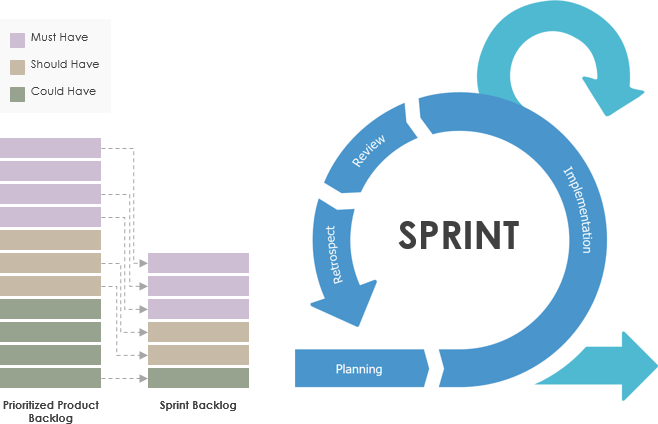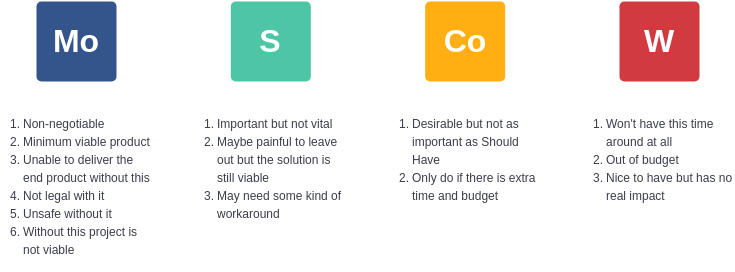Prioritizing Success: A Journey through MoSCoW in E-Commerce Development
Introduction
In the fast-paced world of e-commerce development, where feature requests abound and resources are limited, effective prioritization becomes the key to success. The MoSCoW method, a powerful tool in Agile project management, offers a structured approach to navigating the complexities of decision-making. In this scenario, we explore how a software development team utilizes the MoSCoW method to prioritize features for a new e-commerce platform, ensuring the delivery of a robust and functional product within tight deadlines.
What is MoSCoW Prioritization
In the dynamic world of project management, the ability to prioritize effectively can make or break a project’s success. One such method that has gained prominence, especially in Agile development, is the MoSCoW method. This technique, also known as MoSCoW prioritization or MoSCoW analysis, provides a structured approach to understanding and prioritizing project requirements. Let’s delve into the acronym itself to unravel the essence of the MoSCoW method.

MoSCoW is an acronym derived from four distinct prioritization categories, each representing a level of importance attached to a requirement:
-
Must (Mo):
- These are the non-negotiable, critical requirements that form the backbone of the project. If any Must requirement is overlooked or excluded, the entire release is considered incomplete. These are the pillars that support the project’s functionality and are fundamental to its success.
-
Should (S):
- Unlike Must requirements, Should requirements are important but not critical for the initial release. They contribute significantly to the project’s value but are more flexible in terms of timing. This category allows for a certain degree of prioritization within the project timeline.
-
Could (Co):
- The Could requirements are desirable but not mandatory for the release. These often represent features or improvements that, if included, enhance the overall product. While not critical, they contribute to the project’s quality and user satisfaction. Could requirements are usually seen as low-cost enhancements.
-
Would (W):
- The least critical or non-strategic requirements fall into the Would category. These may not align with the immediate project strategy and can be deferred to future releases. While they might bring value at some point, they are not essential for the initial success of the project.
The Power of Prioritization
The MoSCoW method empowers project teams and stakeholders by fostering clear communication and alignment on priorities. By categorizing requirements into these four distinct levels, the method enables teams to make informed decisions on resource allocation, time management, and feature development.
-
Clear Communication:
- The method provides a common language for stakeholders and team members to express and understand the criticality of each requirement. This clarity minimizes misunderstandings and ensures that everyone is on the same page regarding project priorities.
-
Effective Resource Allocation:
- Resources, including time, manpower, and budget, can be allocated efficiently based on the prioritization levels. Must requirements receive immediate attention, followed by Should and Could requirements. This ensures that the core functionality is robust before adding enhancements.
-
Adaptability to Change:
- In the dynamic landscape of software development, changes are inevitable. The MoSCoW method allows teams to adapt to changes in requirements by reassessing and reprioritizing as needed. This flexibility is crucial in Agile environments where responsiveness to change is a core principle.
-
Risk Mitigation:
- Prioritizing requirements helps in identifying and addressing potential risks early in the project lifecycle. By focusing on Must requirements first, teams can ensure that the essential components are solidified, reducing the risk of project failure.
In the realm of Agile development, where adaptability and responsiveness are paramount, the MoSCoW method stands as a powerful tool for successful project delivery. By categorizing requirements into Must, Should, Could, and Would, teams gain a nuanced understanding of their priorities, fostering effective communication and resource allocation. As projects evolve, the MoSCoW method provides the flexibility needed to navigate changes while maintaining a focus on the essential elements that define success.
MoSCoW Example: e-commerce platform
Let’s imagine a scenario in which a software development team is working on a project to launch a new e-commerce platform. The team is faced with tight deadlines, limited resources, and a variety of feature requests from stakeholders. Using the MoSCoW method will help the team prioritize these features effectively.
Scenario:
The e-commerce platform project has the following feature requests:
-
Must (Mo):
- Secure Payment Gateway: Without a secure payment gateway, the entire purpose of the e-commerce platform is compromised. If customers can’t trust the payment process, the release is deemed unfulfilled.
-
Should (S):
- User Account Management: While not as critical as the payment gateway, the ability for users to create accounts, log in, and manage their profiles is important for a personalized shopping experience. This feature is significant but can be implemented after ensuring the secure payment gateway.
-
Could (Co):
- Social Media Integration: Integrating the platform with social media for sharing and promotions is a desirable feature that could enhance user engagement. However, it’s not mandatory for the initial release and can be considered a low-priority enhancement.
-
Would (W):
- Virtual Reality Shopping Experience: A futuristic and innovative feature that allows users to experience virtual reality-based shopping. While intriguing, this feature may not align with the current project strategy and can be deferred to future releases.
MoSCoW Prioritization:
-
Must (Mo):
- Secure Payment Gateway
-
Should (S):
- User Account Management
-
Could (Co):
- Social Media Integration
-
Would (W):
- Virtual Reality Shopping Experience
By using the MoSCoW method, the team can focus their immediate efforts on implementing the secure payment gateway, ensuring the core functionality of the e-commerce platform is robust. Once that critical aspect is addressed, they can move on to implementing user account management, followed by the optional features like social media integration. The virtual reality shopping experience, while exciting, can be considered for future releases, allowing the team to prioritize resources effectively and deliver a functional and secure e-commerce platform on time.

Summary
In our e-commerce development journey, the MoSCoW method acts as a compass, guiding the team through the intricate landscape of feature prioritization. The critical Secure Payment Gateway takes center stage as a ‘Must,’ ensuring the platform’s foundation is rock-solid. Following closely is the ‘Should’ category, highlighting the importance of User Account Management for a personalized user experience. As we delve into ‘Could’ and ‘Would,’ the team strategically plans for future releases, balancing innovation with immediate necessities. Through this prioritization lens, the team optimizes resources, mitigates risks, and sets the stage for a successful e-commerce platform launch.
Create a MoSCoW Method diagram online
MoSCoW Prioritization Template
MoSCoW Prioritization and Scoping





